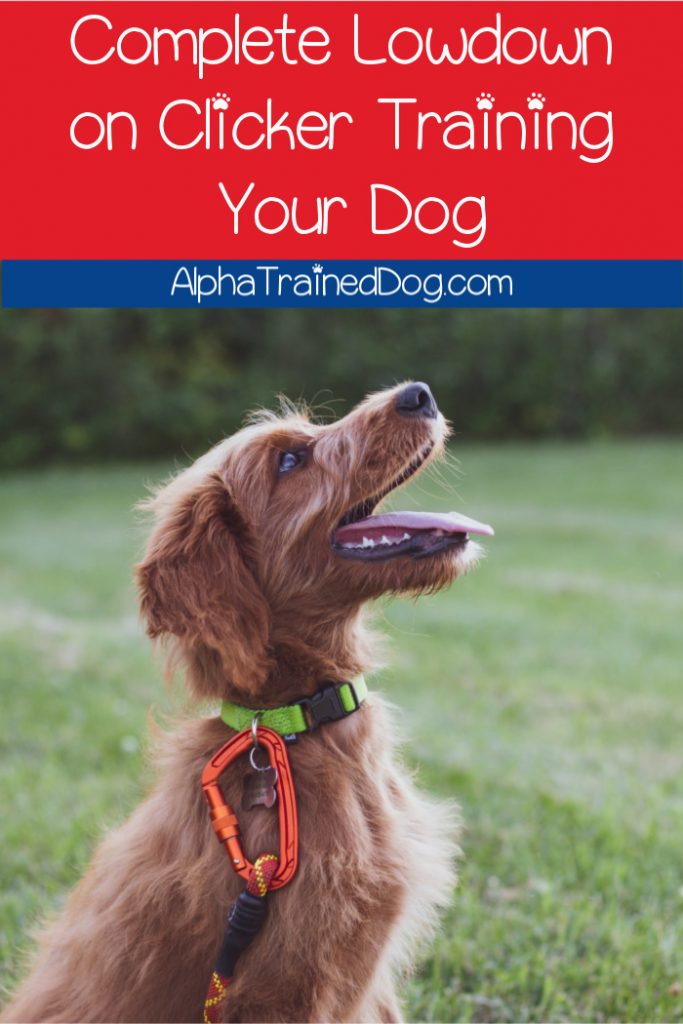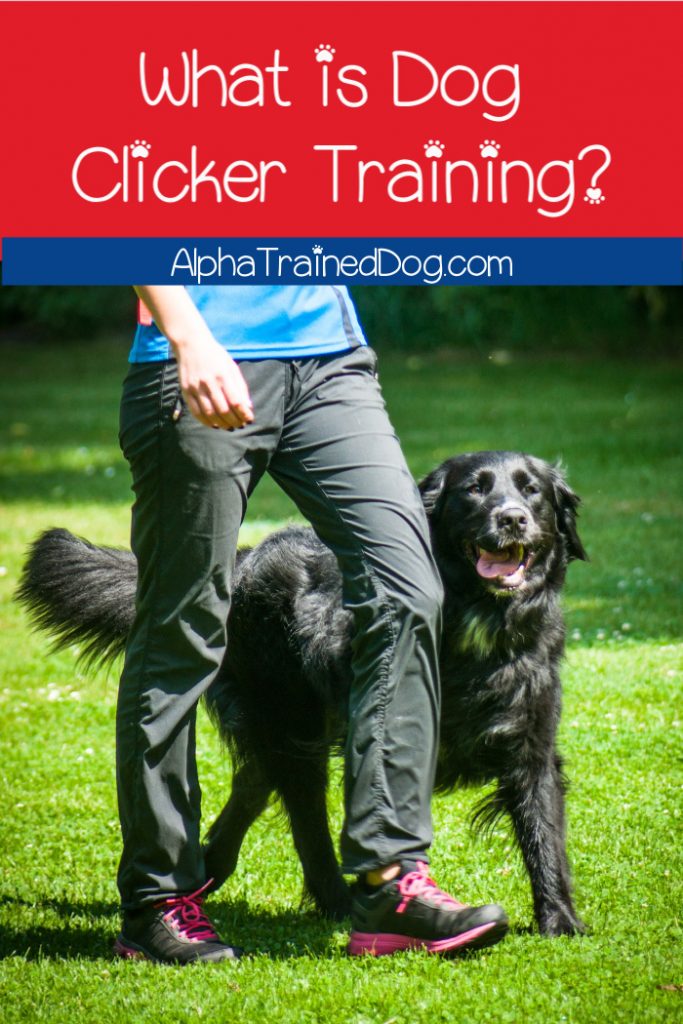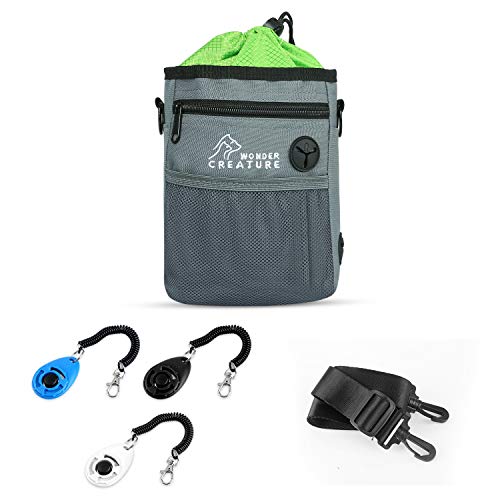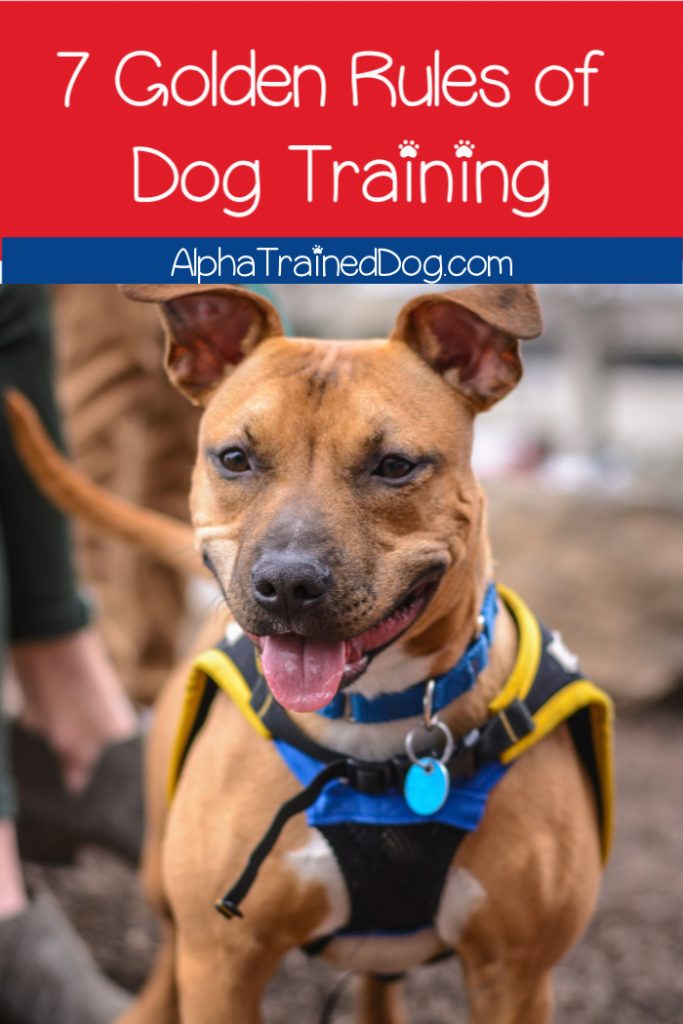If you’re new to dog clicker training, get ready for the complete lowdown on this popular positive reinforcement method!
We’ll cover everything you need to know, from how it works to how to get started!
We’ll even cover some “golden rules” that really apply to all force-free training methods.
Grab your coffee and let’s get started!

Complete Lowdown on Dog Clicker Training
We all know that dog training is a necessity, right?
I mean, no one wants to live in a home where their dog uses every corner as a toilet, barks at all hours, and basically runs the entire show!
It doesn’t matter if your pup is the small enough to fit in a teacup or so large that he needs his own king-size bed. Training is a must. Period.
The big question is how to go about it, since there are so many types of dog training strategies (including one you should never use).
One of the most popular types is clicker training.
No, scratch that. Clicker training isn’t exactly a type of strategy but rather a complement to other reward-based methods.
Take a look at the video below for an overview, then we’ll dig into the details.
What is clicker training?

Basically, dog training is all about communication. You tell your dog which behaviors you expect and when.
The problem? Fido doesn’t speak human. Well, not fluently enough to communicate complex concepts like “Hey, we don’t pee on the rug! We do that outside!”
You also aren’t fluent enough in “dog” right off the bat to fully understand that Fido is feeling tired, annoyed, freaked out, scared, happy, sad, excited.
Training gives you and your dog a chance to get to know each other, to speak the other’s language.
However, like all languages, it takes time to master. That’s where clickers come in handy.
Dog training clickers are great early communication tools
The principle behind clicker training is that the click noise given off by the clicker means your dog has performed a correct action.
In other words, clickers act as markers that tell your dog “Hey, that’s exactly what I want you to do!”
They are effective training tools for puppies or dogs because dog clickers make a very distinct sound.
They also let you control your timing and eliminate any confusion caused by your voice inflection.
In other words, a clicker never sounds too tired, enthused, annoyed, or frustrated the way your voice does.
Dogs are very sensitive to your tone. Remember, they don’t really speak human just yet. To them, “Great job!” only means “great job” when said in the right tone.
If you’re bored and kind of just mumbling it, it’s ineffective. I’ve seen it myself with my own dog!
Now that you have a good idea of WHY you’d want to use a clicker, let’s learn HOW to effectively use it.
FYI, the rest of this post contains affiliate links. If you make a purchase through these links, we earn a small commission at no extra charge to you.
How to get started with clicker training

To get started clicker training all you need is a clicker, a reward and a willing dog.
Now that you’ve got all three, it is time to train your dog to get used to the tool.
First things first; get yourself a nice pocket full of your dog’s favorite small training treats. Small is key, and you’ll see why in a minute.
I like these by Zukes:
- Zuke's Mini Naturals Soft Dog Treats for Training, Low Calorie Dog Training Treats with Chicken Recipe
- At 2 calories per treat, Zuke's chicken dog treats are the perfect low calorie dog treats for training your dog
- Real chicken is the first ingredient in these soft chewy dog treats for large dogs, medium dogs, and small dogs
- Zuke's Mini Naturals dog treats offer your dog soft treats with natural ingredients like chicken and cherries for wholesome, healthy dog treats made without corn, wheat, or soy
- These doggy treats come in a convenient, resealable pouch for easy on-the-go rewards, making them the perfect training treats for dogs that love to live life off leash
Then, get your pup into training mode. When I take a piece of cheese into the living room and stand a certain way, my dog knows it’s business time.
Once you’re in position, it’s time to break out the clicker. Here’s how it’s going to go:
- Show your dog the clicker, then offer a small treat.
- Click it and treat. Click it and treat. Click it and treat. (See why we went with small treats?).
You can continue the process of making clicks and rewarding with treats until you’ve trained your dog to react quickly by turning towards the sound.
Really, this part shouldn’t take too long, although you may need to reinforce the positive connection once during each training session over the first few days.
Once he knows that clicks equal treats, use them to “mark” correct actions. For example, tell him to sit. When he does, click, then treat.
Rate and Reinforcement
The main things to consider when clicker training are rate of reinforcement, timing and motivation.
Rate of reinforcement is all about how often your reward and how much of a reward you give.
When first starting you should reward often and quickly. You need to reward as soon as the dog has performed the correct behavior.
As your dogs understanding increases the rate of reinforcement can be decreased and your dog should be holding the correct behavior longer.
Timing is extremely important in any dog training you must use the clicker the millisecond your dog performs the correct behavior.
Clicker training is all about timing the quicker you click and reward the faster the dog will learn the new behavior.
Why click at all? Why not just treat?
By this point, I know at least some of you are wondering why you should bother with the extra step. If you’re going to click, then treat, why not just skip the click?
Honestly, you could just do that. Clicker training isn’t a must. However, it does help a lot when you get to advanced training.
My dog has a training routine that involves different steps between treats. She sits and gives her paw- two separate commands.
If I click on the sit, she knows she’s on the right track. Then, she has to lie down and wait while I back across the room.
Again, a click marks “lie down,” and “wait.” She gets the treat when I give the “come” signal.
Clicker dog training also helps a lot with recall! At some point you’ll need to call your dog to you from far away. The other end of your back yard, home, or dog park, for example.
During recall training, your goal is to get your dog to come when called. If you click the moment he moves towards you, he’ll learn that a treat is coming.
Okay, so we know why and how clicker dog training works. Now, let’s talk some golden rules. These apply to ALL methods of training.
Golden Rules of Clicker Training

Whatever stage of training you have reached,or whatever method of training you may have chosen, always remember these golden rules;
1. Be Positive
As we’ve seen in past articles, positive reinforcement will get you a lot farther with your dog than punishment-based training.
Train your dog by using clickers and treats, not threats and violence.
Please, if you follow only one tip, make it this one. Dogs have feelings too and they deserve kind and gentle owners.
2. Be Firm Yet Gentle
When you give commands such as stay and come, you want to use a happy, friendly voice.
On the other hand, you will want a lower, firmer voice for sit, down, and stay.
However, when you’re using your firm voice, keep it gentle. Yes, I know, it’s an oxymoron, but you can be firm without sounding mean!
3. Start Young (But Don’t Worry if You Can’t)
The ideal time to start training begins at six to eight weeks, maybe even earlier depending on the puppy.
But remember, you can teach old dogs new tricks. So, if you adopt an older dog, don’t think you missed your chance to train him!
4. Be Patient
Patience is vital when you work with your dog. He WILL get it wrong sometimes.
He’s going to frustrate you and occasionally make you question your ability to train him.
If you can’t push down your impatience, take him to a professional. There’s no shame in admitting that you need help!
5. Keep it Short
Fifteen minutes or so is about the right time for learning simple commands.
At first, you’ll want to concentrate on a single command each session and end it on a positive note.
Once he’s mastered all of the basics, you can move onto advanced training.
Still, even if you’re working on full agility routines, keep the session under about 30 minutes.
6. No Distractions
Try to pick a quiet place free of distractions when training your dog. A secluded garden or a quiet inside room works best.
If there are other pets in the family, put them separate so they wont interfere with training.
After Fido has mastered essential commands, you can work on increasing distractions.
Just remember this rule of thumb- distracting the environments demand higher value treats.
7. Make it enjoyable for both of you
Dog training may not always be fun (how much entertainment can one get from teaching their dog to pee outside, after all), but it should be pleasant for both of you.
Remember, clicker dog training (or any method, really) isn’t just about teaching your dog what to do, it’s about creating a strong bond that will last a lifetime.




I had a friend who was super awesome about training dogs. That was his specialty. I know some of these tips were things he did, very useful information for anyone trying to use dog clicker training.
This sounds like such a great way to train your dog. I know a lot of people who I would recommend this to!
I had never heard of clicker training before but it sounds like a great idea. It’s true that voice commands can be received differently depending on the tone of your voice.
This sounds super interesting! I will have to let my friends with dogs know about it!